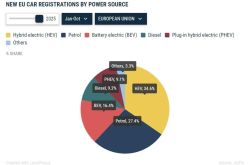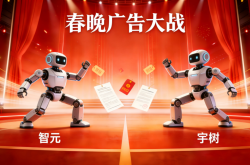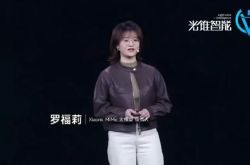NVIDIA GTC 2025: Teradyne Robotics' Collaborative Robotics Innovation
![]() 03/24 2025
03/24 2025
![]() 622
622
Produced by Zhineng Technology
At the NVIDIA GTC 2025 conference, Teradyne Robotics, alongside its subsidiaries Universal Robots (UR) and Mobile Industrial Robots (MiR), debuted AI accelerator-powered robotic solutions. This marks the inaugural commercial endeavor in AI-driven collaborative robotics, signifying a pivotal shift in bringing Physical AI technology from theoretical construct to tangible reality.
Leveraging the NVIDIA Isaac platform and Jetson AGX Orin module, the AI accelerator equips collaborative robots with perception, adaptability, and decision-making abilities through deep learning, reinforcement learning, and generative AI. This advancement showcases groundbreaking applications in dynamic metrology, intricate assembly, and logistics navigation.
NVIDIA's promotion of general-purpose AI humanoid robots at the conference further contextualizes Teradyne's technological advancements within an industrial framework.
We delve into the AI accelerator's core competencies and application value, examining its impact on the collaborative and general AI robot ecosystems from both technological innovation and industrial trend perspectives. Additionally, we explore how Teradyne can seize the initiative in the global robotics landscape.
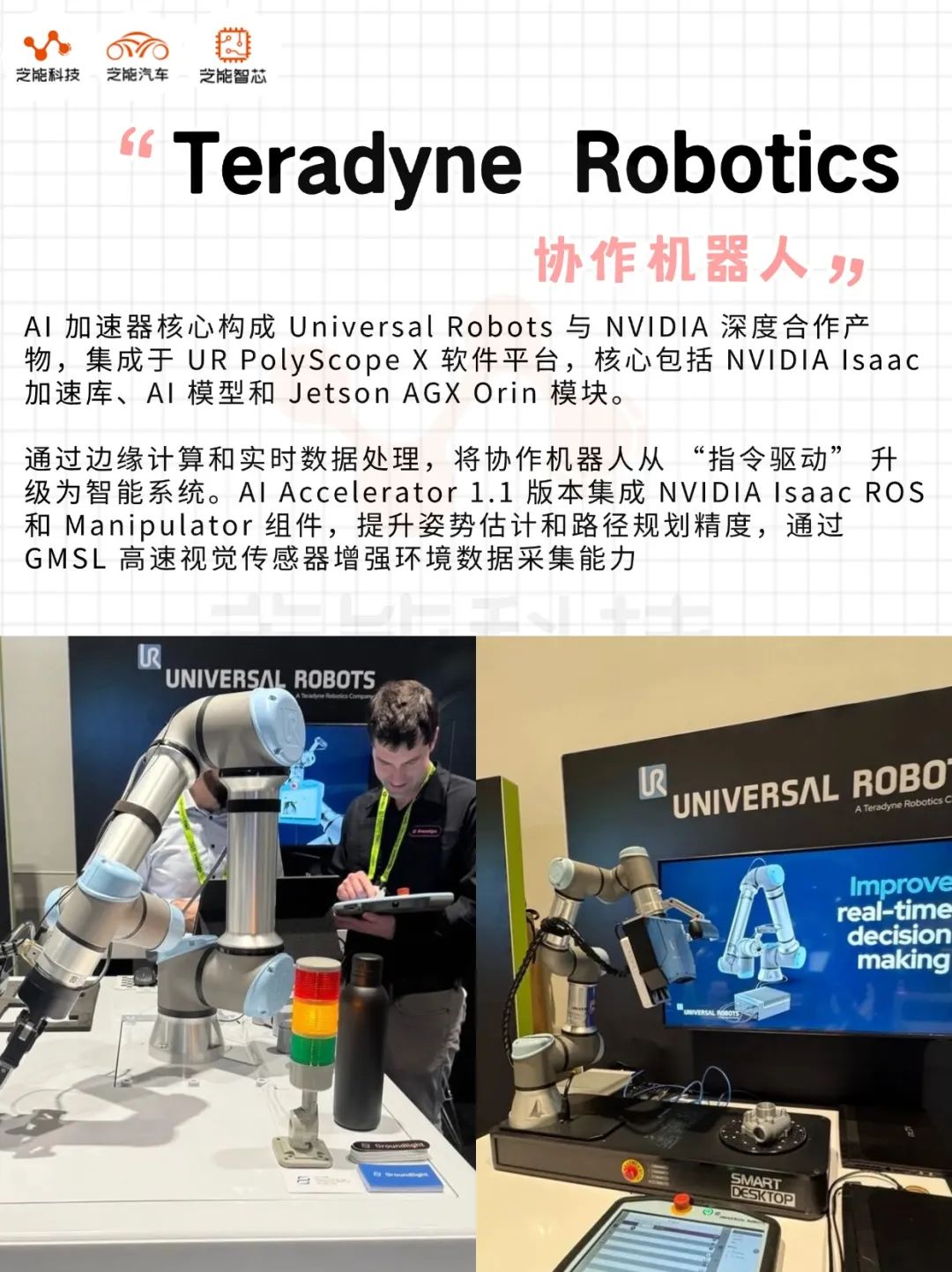
01
Technological Innovation:
Core Capabilities of the AI Accelerator and Application Breakthroughs
Teradyne Robotics' AI accelerator is a product of a deep collaboration between Universal Robots and NVIDIA. As an integral toolkit within the UR PolyScope X software platform, its technological foundation comprises the NVIDIA Isaac acceleration library, AI models, and the high-performance Jetson AGX Orin computing module.
This architecture transforms collaborative robots from traditional "instruction-driven" systems to intelligent entities capable of environmental perception, autonomous learning, and dynamic decision-making through edge computing and real-time data processing.
The latest iteration, AI Accelerator 1.1, further refines functionality by integrating NVIDIA Isaac ROS and Manipulator components, enhancing pose estimation accuracy and path planning. Additionally, it bolsters environmental data collection capabilities through GMSL high-speed vision sensors.
Teradyne's Chief AI Officer, James Davidson, emphasized that the essence of Physical AI lies in equipping robots with the ability to comprehend and respond to the real world.
For instance, in logistics settings, robots must navigate ever-changing layouts, while on construction sites, they handle unpredictable assembly tasks. The AI accelerator enables robots to analyze sensory inputs, devise optimal paths, and efficiently execute tasks through deep learning algorithms and real-time computing.
This shift from "passive execution" to "active adaptation" not only transcends the functional confines of traditional collaborative robots but also presents novel solutions for automation in complex environments.
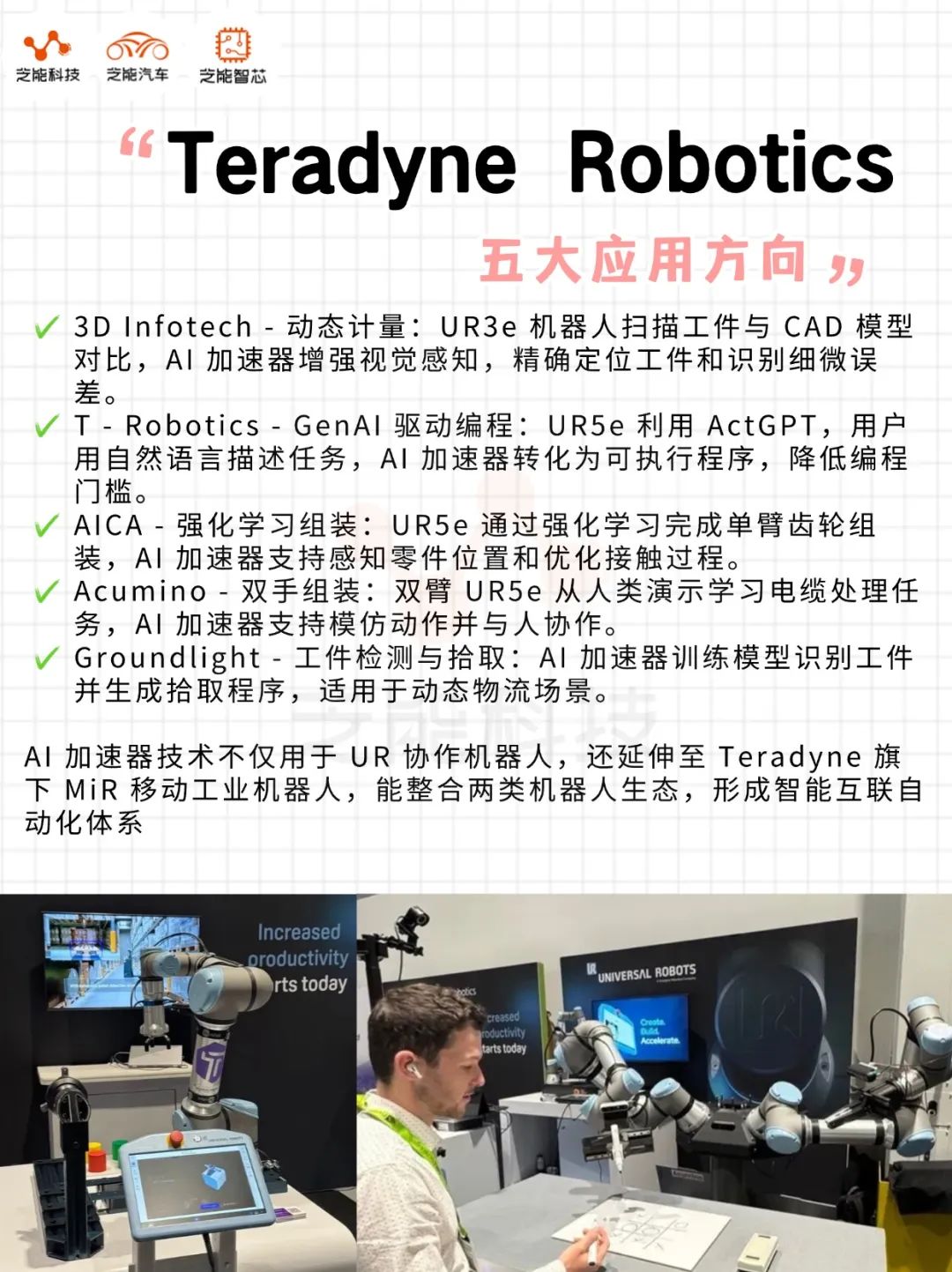
● Five Showcase Applications at GTC 2025
At NVIDIA GTC 2025, Teradyne presented five AI accelerator-driven collaborative robot solutions spanning various domains such as industrial inspection, programming optimization, and intricate assembly, showcasing its technological depth and versatility:
◎ 3D Infotech - Dynamic Metrology: The UR3e collaborative robot scans workpieces and compares them with CAD models to project dimensional deviations in real-time. The AI accelerator augments the robot's visual perception, enabling precise workpiece location and subtle error detection, setting a new benchmark for quality control in smart manufacturing.
◎ T-Robotics - GenAI-Powered Programming: The UR5e utilizes ActGPT, driven by a large language model (LLM), allowing users to describe tasks in natural language, which the AI accelerator converts into executable programs. This innovation lowers the programming barrier and fosters robot adoption in SMEs.
◎ AICA - Reinforcement Learning Assembly: The UR5e performs single-arm gear assembly through reinforcement learning, with the AI accelerator supporting part position perception and contact process optimization, demonstrating high-precision task potential.
◎ Acumino - Dual-Arm Assembly: The dual-arm UR5e learns cable handling tasks from human demonstrations, with the AI accelerator facilitating imitation of complex movements and human-robot collaboration, underscoring the value of human-robot synergy in flexible production.
◎ Groundlight - Workpiece Inspection and Picking: The AI accelerator trains models to recognize workpieces and generate picking programs, ensuring operational robustness, ideal for dynamic logistics scenarios.
These applications illustrate the AI accelerator's advancements in enhancing robots' autonomy, flexibility, and user-friendliness, providing tangible examples for developers.
Ujjwal Kumar, President of Teradyne Robotics Group, emphasized that the AI accelerator, as a scalable platform, mitigates development risks and accelerates application deployment, solidifying UR's leadership in Physical AI.
The AI accelerator's technology extends beyond UR's collaborative robots to Teradyne's MiR mobile industrial robots. For example, the MiR1200 pallet truck leverages 3D vision and the Jetson AGX Orin module for precise pallet detection and handling in complex environments.
This cross-product line application underscores the AI accelerator's versatile underlying technology, capable of integrating Teradyne's collaborative and mobile robot ecosystems into a smarter, interconnected automation system.
NVIDIA and Teradyne's collaboration introduces generative AI and simulation technology to a broader developer community, expediting the industrialization of Physical AI.
02
Industrial Trends:
Integration of the Collaborative Robot and General AI Robot Ecosystems
Collaborative robots (Cobots) have surged in popularity over the past decade due to their safety and human-robot collaboration capabilities. However, with the progression of Industry 4.0 and smart manufacturing, traditional collaborative robots face challenges such as limited functionality, inadequate adaptability, and high programming costs.
Teradyne has overcome these bottlenecks with the AI accelerator, evolving UR robots from mere "tools" to "partners" capable of handling high-mix, low-volume production demands. This transformation aligns well with the global trend towards flexible automation in manufacturing.
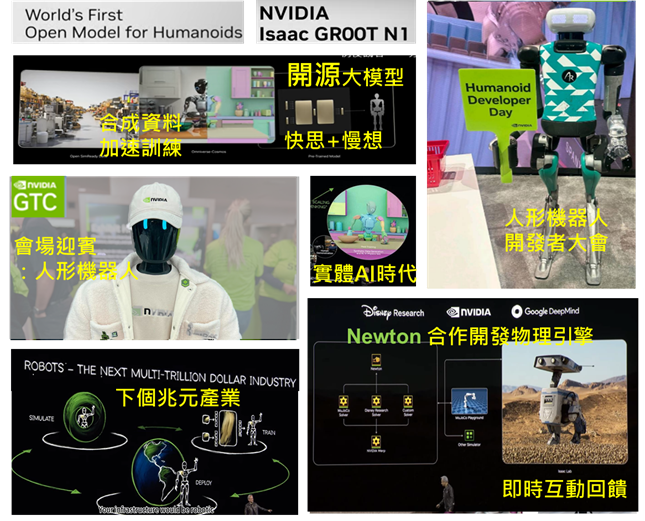
At GTC 2025, Teradyne's showcase indicated its emergence as a pioneering platform for Physical AI.
Compared to competitors like ABB or FANUC, Teradyne's advantage stems from its technological synergy with NVIDIA and its open developer ecosystem. The AI accelerator not only elevates robot performance but also attracts more partners by lowering the development threshold, fostering an innovation network centered around UR.
This ecological strategy positions Teradyne at the forefront of both technological and commercial landscapes in the collaborative robot market, laying the groundwork for future market expansion.
NVIDIA's vision at GTC 2025 posits Physical AI as the ultimate aim of AI development, promoting the evolution of general-purpose AI humanoid robots through the Isaac GR00T platform. NVIDIA anticipates a global labor shortage of 50 million by 2030, presenting trillion-dollar opportunities for robotics technology.
Teradyne's AI accelerator significantly aligns with this vision, as its technical architecture (including reinforcement learning and generative AI) complements the development requirements of humanoid robots.
AICA's reinforcement learning assembly and Acumino's dual-arm collaboration tasks exemplify the ability to learn from human behavior, a cornerstone technology for humanoid robot generalization.
NVIDIA's open-source model GR00T N1 and physics engine Newton provide technical backing to Teradyne, potentially turning its collaborative robots into "testbeds" for humanoid robot development.
In the future, through collaboration with NVIDIA, Teradyne may expand its reach from the collaborative robot sector into the humanoid robot market, capturing a larger share of the industry.
NVIDIA projects that AI robots will extend their reach beyond industrial manufacturing into medical, service, and household scenarios.
Teradyne's AI accelerator has already demonstrated its prowess in industrial applications such as dynamic metrology and complex assembly, while the MiR1200 pallet truck extends its utility to logistics.
Conversely, NVIDIA's partners (like Disney's BDX and 1X's household robots) have introduced Physical AI into the entertainment and household domains. This diversification trend suggests blurring application boundaries between collaborative robots and general AI robots.
Teradyne's strength lies in its deep industrial foundation and UR's global influence. UR's collaborative robots have secured a significant share of the SME market, renowned for their ease of use and safety.
The introduction of the AI accelerator further fortifies this advantage, enabling Teradyne to maintain its leadership in smart manufacturing and logistics. However, to transition from factories to households, Teradyne must address challenges such as cost, reliability, and user acceptance.
Summary
Teradyne Robotics' AI accelerator solution unveiled at NVIDIA GTC 2025 represents a landmark achievement in collaborative robot technology, providing a vivid illustration of Physical AI's commercialization.
Technologically, the AI accelerator imbues robots with new capabilities, ranging from perception to decision-making, through deep learning, reinforcement learning, and edge computing, transcending traditional automation limitations.
Industrially, its collaboration with NVIDIA aligns with the ascendancy of general-purpose AI robots, opening new avenues for the technological integration of collaborative robots and humanoid robots.



